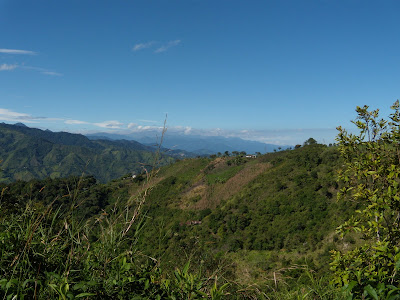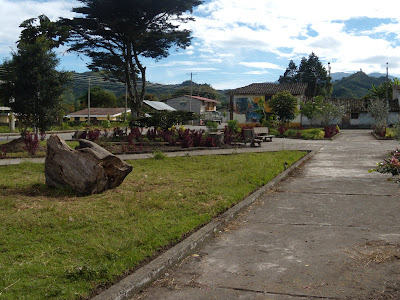I spent about two and a half days with my friends Lily and Athena in Manta, where they are living and teaching in an enormous Catholic church. It’s a really interesting arrangement, and about as different as my situation as I can imagine: they teach parishioners of all ages in three 2-hour classes a day for a whopping six hour total, and instead of a standard host family, they live alongside about six very warm, very funny priests.
I had decided to visit Lily and Athena during my vacation time instead of friends in other parts of the country in large part because the WorldTeach mid-service conference took place on the coast during the last few days of my break, and I wanted to minimize travel time as much as possible. Manta is a ~3-hour bus ride from Puerto Lopez, the nearest city to the resort where the conference took place, so I figured that traveling there would be relatively simple. Thankfully (because I’ve learned to enjoy travel adventures), I was terribly mistaken.
On Tuesday, during an afternoon visit to the Murciélago beach, Lily, Athena, and I had received an incredible offer from a company that runs whale-watching trips from the beach. The summer is humpback whale mating season, and Ecuador’s coast is a hotbed of cetacean love. The friendly whale-boat representative told us that they could take us to Puerto Lopez in a few hours, and we’d be able to enjoy whale-dancing, snorkeling, and even a lunch (of our choice!) along the way—all for the low, low price of $20 each.
We thought the deal sounded pretty good, and the trip a lot more interesting than another bus ride, so (after an extensive verification of the details by phone—we wanted to be sure we could actually land at Puerto Lopez, not just hang around and watch the whales in its waters), we decided to go for it. The three of us, along with Bahía friends Becca and Kasey, arrived at the beach early Thursday morning, ready to travel to Puerto Lopez in nautical style. We were met by our boat-company friend, who, after discussing with a colleague, told us that the boat wouldn’t be able to take us to Puerto Lopez—it would take too long, and the boat couldn´t hold enough fuel to make a round-trip. The best they could do, he said after much deliberation, was to drop us off at another beach only about 45 minutes closer to Puerto Lopez. The boat people were quite apologetic (though certainly not very explanatory) about the misunderstanding, and offered to leave one representative—a colorful character named Jimmy—with us to help us find a bus to our destination and ¨protect¨ us. They even offered to pay for our bus tickets to Puerto Lopez.
We sighed, haggled for a discount, waited for another hour and a half, and were finally off. The whale-watching was wonderful, if extremely wet, but the snorkeling gear was left on shore, and we missed out on the advertised lunch because we were dropped off early. As promised, Jimmy stayed with the gang. After a culturally educational lunch (Jimmy had no qualms about sharing his opinions on serranos and Afro-Ecuas—both negative) we caught a camioneta to the next town over, where Jimmy told us we would have an easier time finding a bus.

In fact, he told us as we disembarked and assembled on a corner under a store awning, a bus to Puerto Lopez would be arriving “ya mismo,” a phrase that literally means “right now,” but (as we found out) in practice is used more like “Soon! Really, probably in the next few hours!” We waited two hours for a bus, and when it finally came, we were so anxious to get a move on that we forgot to remind Jimmy to pay. Though Manta was closer than any other site to the conference, thanks to the culturally enlightening scenic route we took, our group managed to arrive two hours late, after all the other volunteers.
The conference itself was nice, though I probably learned more (and spent more time) in getting to and from the event than I did actually being there. We had several sessions on various teaching topics and cultural adjustment, but for me, the best part of the conference was continuing my vacation pastime of reconnecting with volunteer friends after three weeks of relative isolation.
When I filled out the survey telling WorldTeach what type of teaching site I would most prefer, I asked for a small, rural community where I´d be able to get to know people well and have an experience completely different from my life in the states—Peñaherrera in a nutshell. I´ve happily adapted to a new diet, been almost completely immersed in Spanish, and felt welcomed by my neighbors, things that might not have happened in a more urban site or a place where I had another WorldTeach volunteer to keep me company. However, the side effect of these advantages is a feeling of isolation that extends far beyond homesickness. I found it incredibly refreshing to talk about my pent-up frustrations about my classroom situation and the sometimes baffling Ecuadorian culture with people who shared them. When the other volunteers and I weren´t busy chatting or listening to classroom management/lesson planning/etc. advice from the WorldTeach higher-ups, we built an impressive sandcastle and sang 90’s pop songs around a massive beach bonfire.

I can summarize my trip home to Peñaherrera by saying that it was an octopus of a journey—instead of the usual two or three stages, this trip had eight major legs (and a few smaller ones). It involved: 2 trucks (one ride in the cab, one in my familiar post in the back, hanging tight to a metal railing), 5 long-distance buses, 2 trolleybuses, 1 local bus, 1 taxi, and 1 cheap hotel, for a total of 28.5 hours on the road. I was traveling alone, since the other INTAG volunteers had their school vacations immediately after the conference, but as I mentioned in my previous post, I received lots of help from very kind strangers.
When my last bus finally pulled into Peñaherrera and I was greeted by familiar storefronts, faces, and sounds (roosters, mostly), I was surprised to realize how nice it was to be back. The regular Sunday afternoon cameon to El Paraíso was waiting for me, along with Alvino, who met me with a firm handshake and a broad smile. The bouncy ride through the green mountains never seemed so beautiful.




























